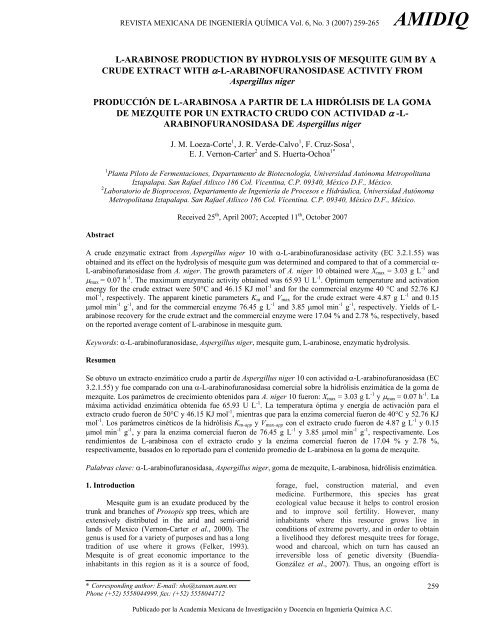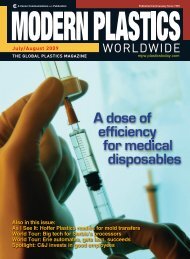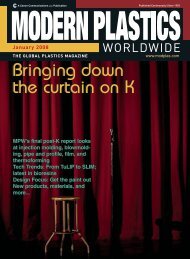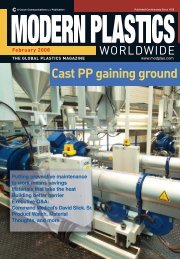amidiq - dae uptlax
amidiq - dae uptlax
amidiq - dae uptlax
Create successful ePaper yourself
Turn your PDF publications into a flip-book with our unique Google optimized e-Paper software.
REVISTA MEXICANA DE INGENIERÍA QUÍMICA Vol. 6, No. 3 (2007) 259-265 AMIDIQ<br />
L-ARABINOSE PRODUCTION BY HYDROLYSIS OF MESQUITE GUM BY A<br />
CRUDE EXTRACT WITH α-L-ARABINOFURANOSIDASE ACTIVITY FROM<br />
Aspergillus niger<br />
PRODUCCIÓN DE L-ARABINOSA A PARTIR DE LA HIDRÓLISIS DE LA GOMA<br />
DE MEZQUITE POR UN EXTRACTO CRUDO CON ACTIVIDAD α -L-<br />
ARABINOFURANOSIDASA DE Aspergillus niger<br />
* Corresponding author: E-mail: sho@xanum.uam.mx<br />
Phone (+52) 5558044999, fax: (+52) 5558044712<br />
J. M. Loeza-Corte 1 , J. R. Verde-Calvo 1 , F. Cruz-Sosa 1 ,<br />
E. J. Vernon-Carter 2 and S. Huerta-Ochoa 1*<br />
1 Planta Piloto de Fermentaciones, Departamento de Biotecnología, Universidad Autónoma Metropolitana<br />
Iztapalapa. San Rafael Atlixco 186 Col. Vicentina, C.P. 09340, México D.F., México.<br />
2 Laboratorio de Bioprocesos, Departamento de Ingeniería de Procesos e Hidráulica, Universidad Autónoma<br />
Metropolitana Iztapalapa. San Rafael Atlixco 186 Col. Vicentina. C.P. 09340, México D.F., México.<br />
Abstract<br />
Received 25 th , April 2007; Accepted 11 th , October 2007<br />
A crude enzymatic extract from Aspergillus niger 10 with α-L-arabinofuranosidase activity (EC 3.2.1.55) was<br />
obtained and its effect on the hydrolysis of mesquite gum was determined and compared to that of a commercial α-<br />
L-arabinofuranosidase from A. niger. The growth parameters of A. niger 10 obtained were Xmax = 3.03 g L -1 and<br />
μmax = 0.07 h -1 . The maximum enzymatic activity obtained was 65.93 U L -1 . Optimum temperature and activation<br />
energy for the crude extract were 50°C and 46.15 KJ mol -1 and for the commercial enzyme 40 °C and 52.76 KJ<br />
mol -1 , respectively. The apparent kinetic parameters Km and Vmax for the crude extract were 4.87 g L -1 and 0.15<br />
μmol min -1 g -1 , and for the commercial enzyme 76.45 g L -1 and 3.85 μmol min -1 g -1 , respectively. Yields of Larabinose<br />
recovery for the crude extract and the commercial enzyme were 17.04 % and 2.78 %, respectively, based<br />
on the reported average content of L-arabinose in mesquite gum.<br />
Keywords: α-L-arabinofuranosidase, Aspergillus niger, mesquite gum, L-arabinose, enzymatic hydrolysis.<br />
Resumen<br />
Se obtuvo un extracto enzimático crudo a partir de Aspergillus niger 10 con actividad α-L-arabinofuranosidasa (EC<br />
3.2.1.55) y fue comparado con una α-L-arabinofuranosidasa comercial sobre la hidrólisis enzimática de la goma de<br />
mezquite. Los parámetros de crecimiento obtenidos para A. niger 10 fueron: Xmax = 3.03 g L -1 y μmax = 0.07 h -1 . La<br />
máxima actividad enzimática obtenida fue 65.93 U L -1 . La temperatura óptima y energía de activación para el<br />
extracto crudo fueron de 50°C y 46.15 KJ mol -1 , mientras que para la enzima comercial fueron de 40°C y 52.76 KJ<br />
mol -1 . Los parámetros cinéticos de la hidrólisis Km-app y Vmax-app con el extracto crudo fueron de 4.87 g L -1 y 0.15<br />
μmol min -1 g -1 , y para la enzima comercial fueron de 76.45 g L -1 y 3.85 μmol min -1 g -1 , respectivamente. Los<br />
rendimientos de L-arabinosa con el extracto crudo y la enzima comercial fueron de 17.04 % y 2.78 %,<br />
respectivamente, basados en lo reportado para el contenido promedio de L-arabinosa en la goma de mezquite.<br />
Palabras clave: α-L-arabinofuranosidasa, Aspergillus niger, goma de mezquite, L-arabinosa, hidrólisis enzimática.<br />
1. Introduction<br />
Mesquite gum is an exudate produced by the<br />
trunk and branches of Prosopis spp trees, which are<br />
extensively distributed in the arid and semi-arid<br />
lands of Mexico (Vernon-Carter et al., 2000). The<br />
genus is used for a variety of purposes and has a long<br />
tradition of use where it grows (Felker, 1993).<br />
Mesquite is of great economic importance to the<br />
inhabitants in this region as it is a source of food,<br />
forage, fuel, construction material, and even<br />
medicine. Furthermore, this species has great<br />
ecological value because it helps to control erosion<br />
and to improve soil fertility. However, many<br />
inhabitants where this resource grows live in<br />
conditions of extreme poverty, and in order to obtain<br />
a livelihood they deforest mesquite trees for forage,<br />
wood and charcoal, which on turn has caused an<br />
irreversible loss of genetic diversity (Buendía-<br />
González et al., 2007). Thus, an ongoing effort is<br />
Publicado por la Academia Mexicana de Investigación y Docencia en Ingeniería Química A.C.<br />
259









